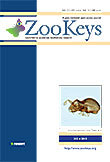Ver ítem
- xmlui.general.dspace_homeCentros Regionales y EEAsCentro Regional Catamarca - La RiojaEEA ChilecitoArtículos científicosxmlui.ArtifactBrowser.ItemViewer.trail
- Inicio
- Centros Regionales y EEAs
- Centro Regional Catamarca - La Rioja
- EEA Chilecito
- Artículos científicos
- Ver ítem
Two new species of the family Nippobodidae (Acari, Oribatida), including a description of the leg-folding process
Resumen
Nippobodes panemorfis sp. n. and Leobodes trypasis sp. n. are described by means of optical and Scanning Electron Microscopy (SEM) and compared to other congeners. The leg-folding process is described and illustrated. Nippobodes panemorfis sp. n. is characterised by interlocking, double hook-shaped, posterior prodorsal condyle and anterior zone humeral apophysis; posterior prodorsal depression present. Tutorium a large lamina defining a pocket-shaped
[ver mas...]
Nippobodes panemorfis sp. n. and Leobodes trypasis sp. n. are described by means of optical and Scanning Electron Microscopy (SEM) and compared to other congeners. The leg-folding process is described and illustrated. Nippobodes panemorfis sp. n. is characterised by interlocking, double hook-shaped, posterior prodorsal condyle and anterior zone humeral apophysis; posterior prodorsal depression present. Tutorium a large lamina defining a pocket-shaped structure; bothridial opening ovoid, situated at the bottom of a U-shaped structure; deep, rounded-ovoid anterior notogastral depression present; ten pairs of notogastral setae; c setae looped, dentate, sharply tipped. Marginal setae h3, p3 on large promontories, followed by deep V-shaped incision; notogaster completely surrounded by circumgastric depression; lateral genital zone with locking structure constituted by longitudinal cuticular elevation, with promontories and a parallel furrow involved in the leg-folding process; genital plate smaller than anal plate.
Leobodes trypasis sp. n. is characterised by: the presence of posterior prodorsal depression and anterior notogastral depression; bridge-shaped anterior prodorsal condyles; heart-shaped frontal prodorsal orifice; ten pairs of notogastral setae; posterior prodorsal condyle and humeral condyle interlocked, forming double hook-like structure; circumgastric furrow surrounding entire notogaster; setae lp, h2, h1 situated on shallow medial furrow; notogastral setae lm, lp, h1, h2 medially aligned; p1, p2, p3, h3 marginally situated. Legs I-IV, tutorium, pedotectum I, and pedotectum II involved in leg folding which is inferred to be a protection mechanism.
[Cerrar]

Autor
Fernandez, Nestor;
Theron, Pieter Daniel;
Leiva, Sergio Dante;
Fuente
ZooKeys 781 : 109-139 (August 2018)
Fecha
2018-08
Editorial
Pensoft Publishers
ISSN
1313-2989
1313-2970
1313-2970
Formato
pdf
Tipo de documento
artículo
Palabras Claves
Derechos de acceso
Abierto
 Excepto donde se diga explicitamente, este item se publica bajo la siguiente descripción: Creative Commons Attribution-NonCommercial-ShareAlike 2.5 Unported (CC BY-NC-SA 2.5)
Excepto donde se diga explicitamente, este item se publica bajo la siguiente descripción: Creative Commons Attribution-NonCommercial-ShareAlike 2.5 Unported (CC BY-NC-SA 2.5)


